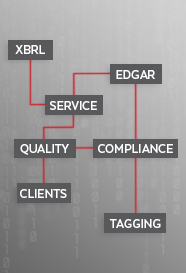XBRL and Inline XBRL FREQUENTLY ASKED QUESTIONS
SEC DISCLOSURE XBRL FAQs
Which financial disclosures are required to be tagged?
The following core financial statements must be tagged:
- Balance sheet
- Income statement
- Statement of Comprehensive Income
- Statement of Cash Flows
- Statement of Stockholder’s Equity
The requirements for financial statement footnotes and schedules are as follows:
- Detailed tagging generally means that all numbers (values) including: facts, figures, percentages, years, etc. will need to have US GAAP concepts applied to them. These include numbers in both the narrative of the disclosure as well as in the tables presented.
- Additionally, US GAAP Concepts will need to be applied to identify tables, entire notes and significant accounting policies (which means narrative information).
- Finally, Financial Schedules included in your disclosures will need to be tagged in the same fashion as described above.
SEC DISCLOSURE XBRL FAQs
How long does a “typical” detailed-XBRL filing take to create and complete?
Short answer: It depends on how complex your financials and notes to financials are.
Creating and Tagging documents in-house requires a considerable investment of capital, employee time, training and maintenance. We have found that this is time and bandwidth most companies are already short on, and when you add the additional accounting expertise necessary to understand changes in the Taxonomy year over year, most companies cannot justify doing this process in-house for only four or five filings per year.
Companies usually exhibit long learning curves to become familiar with the XBRL and Inline XBRL tagging process. The estimated in-house time per filing is in the hundreds of work hours, but RDG takes all of the grunt work out of the process and cuts out well over 90% of the time your staff would need to spend creating and tagging documents with in-house software.
When does my company have to file XBRL?
The SEC mandated timeline is as follows:



